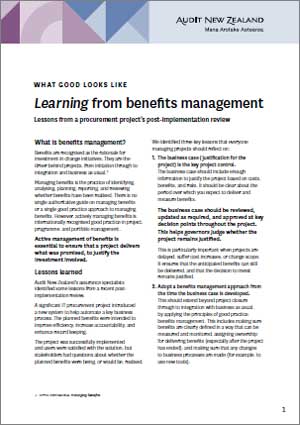What good looks like: Learning from benefits management
What is benefits management?
 Benefits are recognised as the rationale for investment in change initiatives. They are the driver behind projects, from initiation through to integration and business as usual.1
Benefits are recognised as the rationale for investment in change initiatives. They are the driver behind projects, from initiation through to integration and business as usual.1
Managing benefits is the practice of identifying, analysing, planning, reporting, and reviewing whether benefits have been realised. There is no single authoritative guide on managing benefits or a single good practice approach to managing benefits. However, actively managing benefits is internationally recognised good practice in project, programme, and portfolio management.
Active management of benefits is essential to ensure that a project delivers what was promised, to justify the investment involved.
Lessons learned
Audit New Zealand’s assurance specialists identified some lessons from a recent post-implementation review.
A significant IT procurement project introduced a new system to help automate a key business process. The planned benefits were intended to improve efficiency, increase accountability, and enhance record keeping.
The project was successfully implemented and users were satisfied with the solution, but stakeholders had questions about whether the planned benefits were being, or would be, realised.
We identified three key lessons that everyone managing projects should reflect on:
- The business case (justification for the project) is the key project control.
The business case should include enough information to justify the project based on costs, benefits, and risks. It should be clear about the period over which you expect to deliver and measure benefits.
The business case should be reviewed, updated as required, and approved at key decision points throughout the project. This helps governors judge whether the project remains justified.
This is particularly important when projects are delayed, suffer cost increases, or change scope. It ensures that the anticipated benefits can still be delivered, and that the decision to invest remains justified. - Adopt a benefits management approach from the time the business case is developed.
This should extend beyond project closure through to integration with business as usual, by applying the principles of good practice benefits management. This includes making sure benefits are clearly defined in a way that can be measured and monitored, assigning ownership for delivering benefits (especially after the project has ended), and making sure that any changes to business processes are made (for example, to use new tools). - Apply a project management methodology that is based on good practice. Ideally, this methodology will be supported by templates for benefits documentation, including a benefits management strategy, a benefits realisation plan, and benefit profiles. A benefits management strategy describes the whole organisation’s approach to benefits management across the portfolio of change initiatives. It is important that each project’s benefits receive the attention they deserve.
Good practice benefits management principles
Although there is no single authoritative guide on benefits management, we recommend the following principles, based on our experience of post-implementation reviews:2
- Align benefits with your organisation’s strategy so that the contribution the benefits make towards achieving one or more strategic objectives can be measured consistently.
- Start with the end in mind so that initiatives are established to realise benefits, rather than using benefits to justify a pre-selected solution.
- Use successful project delivery methods with effective change management to help embed change and realise benefits.
- Integrate benefits (and measures used) into your organisation’s operational and performance management systems where possible. Make use of available data, align with organisational planning, and provide clarity about responsibility and accountability for benefits management.
- Manage benefits from a portfolio perspective to assist with consistency and efficiency, enabling a ‘clear line of sight’ across all initiatives.
- Apply effective governance for business change, realising benefits by ensuring governance is clear, aligned, consistent, and active.
- Develop a value culture where benefits and benefits management is taken seriously. The focus should be on creating and sustaining value from the organisation’s investments, including after the project has closed.
Above all, remember that projects do not exist to deliver products or implement change for the sake of change. Investment in projects is justified by their ability to deliver real business benefit.
Where to find out more
Office of the Auditor-General's guidance for good practice in governance
Treasury guidance on benefits management
Treasury guidance on better business case development
1: APMG International, Managing Benefits.
2: APMG International, Managing Benefits.
Page last updated: 1 December 2023
